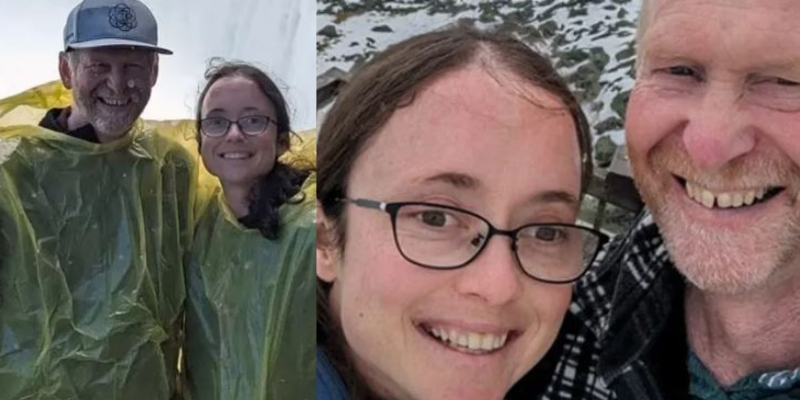Tim and Esther Keiderling departed Abol Campground shortly after sunrise on June 1st, 2025, attracted not only to the northern end of the Appalachian Trail but also to something deeply spiritual. Hiking Katahdin was more than just a pastime for the Keiderlings; it was a religious act. Tim, a devout member of the Bruderhof community and a father of six, considered nature to be sacred. This respect was also shared by his daughter, Esther, who works with him at Rifton Equipment. Unaware of the steep price the mountain would soon demand, they climbed the Hunt Trail together.
By mid-morning, hikers remembered seeing the two close to the summit, continuing despite the rapidly worsening conditions. There were gusts of wind that approached 40 miles per hour. Sleet and swirling snow made the air abrasive. Spring terrain became an alpine wilderness as wind chills plunged into the teens. However, the Keiderlings, who were said to be composed and concentrated, kept moving upward. Their resolve demonstrated devotion—to the ascent, to one another, and to their common goal—rather than conceit.
Father Daughter Katahdin Tragedy – Key Details Table
| Detail | Information |
|---|---|
| Names | Tim Keiderling (58), Esther Keiderling (28) |
| Origin | Ulster Park, New York |
| Incident Date | June 1, 2025 |
| Discovery Dates | Tim on June 3, Esther on June 4 |
| Location | Mount Katahdin, Baxter State Park, Maine |
| Route Taken | Hunt Trail (ascent), Saddle Trail (descent) |
| Last Seen | Near summit, midmorning, during worsening weather |
| Conditions at Summit | Wind gusts up to 40 mph, sleet, rain, snow, wind chills in the teens |
| Cause of Death (Esther) | Multiple blunt force injuries sustained in a steep boulder field |
| Cause of Death (Tim) | Undetermined; hypothermia suspected |
| Spiritual Affiliation | Bruderhof Communities |
| Workplace | Rifton Equipment, medical manufacturing firm |
Unfortunately, their trip turned into a terrifying metaphor for how quickly the beauty of nature can turn dangerous. Tim’s body was discovered first, tucked away in the windswept Tableland, only 0.3 miles from the summit. About a thousand feet downhill, Esther’s was recovered the following day. Authorities think she slid uncontrollably across a slippery boulder field after losing her footing during descent. She most likely crashed into snow-covered hidden rocks before succumbing to multiple blunt force injuries. Although the cause of her father’s death is still unknown, hypothermia is the most likely suspect.
It is hard to overlook the tragic irony of their defeat on the way down after reaching the summit, their intended objective. Even though descent is a major cause of death in hiking communities, it is frequently underappreciated. The risk is increased by exhaustion, confusion, and changing terrain. With the weather getting worse, Tim and Esther had to gamble blindly every step of the way down from the summit. In terrain that is particularly resilient to rescue and visibility efforts, that gamble proved to be fatal.
Their story poses important questions in light of the growing popularity of outdoor recreation. Are hikers completely aware of the risks associated with peaks like Katahdin during the shoulder season? Does the infrastructure for trail safety keep up with the increasing number of summit attempts? Trail traffic has significantly increased since the pandemic, frequently from hikers with varying levels of experience. The Keiderlings were no amateurs, but their tale demonstrates how even experienced, motivated explorers can be caught off guard by sudden changes in their surroundings.
Family members have publicly expressed their grief and faith in remarkably clear ways, without anger. Heinrich Arnold, Tim’s brother-in-law, called the death “a heartbreaking tragedy,” but he found solace in the fact that the two “were immersed in the raw and wild beauty of creation.” This expression of peace in the midst of suffering has struck a particularly deep chord with spiritual communities and hikers who view nature as a means of connection rather than merely a place to visit.
Similar opinions were expressed by their employer, Rifton Equipment. The company, which is well-known for producing assistive technology for people with disabilities, highlighted the Keiderlings’ extensive community involvement and long history of service. They thanked first responders, said the couple “succumbed to exposure,” and asked for continued prayers in a statement. It was a heartfelt and sobering response—one that expressed gratitude for lives well lived rather than placing blame.
Their story has started to move rescue coordinators, park officials, and mountaineering groups to talk about the climb’s dangers and its reverence. More real-time trail warnings are already being discussed, especially during the spring when weather patterns are still dangerously unpredictable above tree lines. The intention is to empower rather than to discourage, making sure that physical safety and spiritual connection do not have to conflict.
This story is now more than just a local report thanks to clever storytelling. It has subtly underlined the value of readiness, modesty, and regard for the terrain. The public has been profoundly affected by the emotional texture that their decision to hike together—father and daughter—adds. Families are now reassessing their preparedness after previously taking the trail for granted. Checklists are being updated by groups. People are reconsidering the concept of summiting with awareness.
Esther and Tim weren’t careless. They were merely caught in a situation where terrain and timing coincided. Their legacy, now preserved in innumerable headlines and emotional social media posts, has a remarkable impact on changing the conversation about hiking safety. Their last moments, in silence, wind, and snow, show both fragility and bravery. Their memory challenges us to reconsider what adventure means, particularly in light of the fact that nature embodies both danger and glory in one frozen breath.

